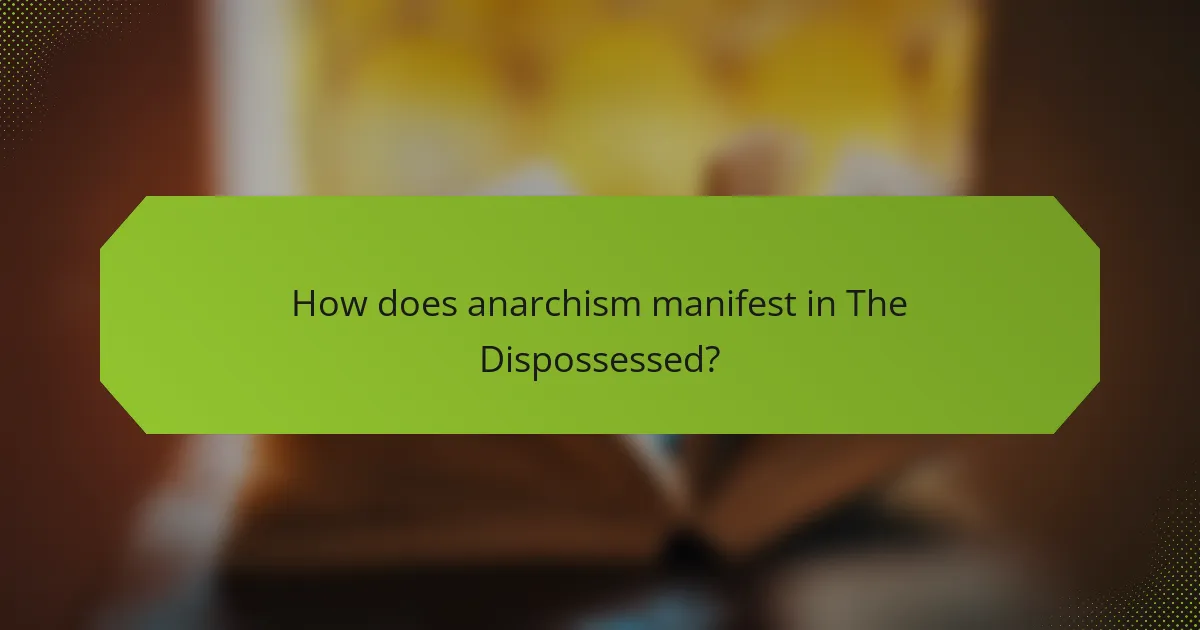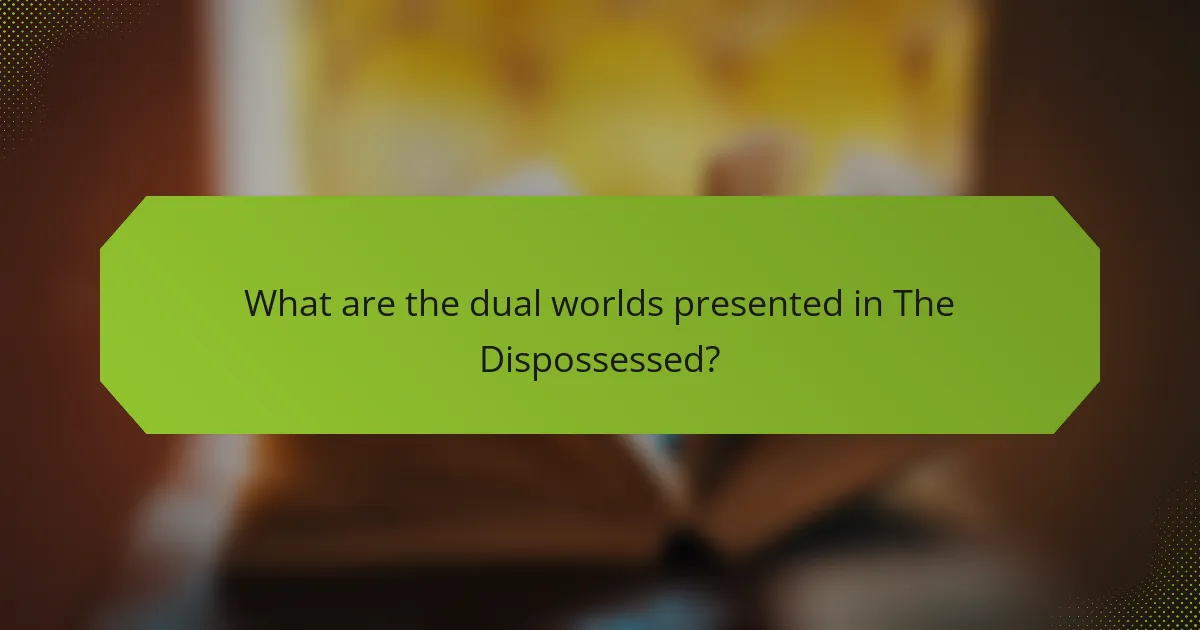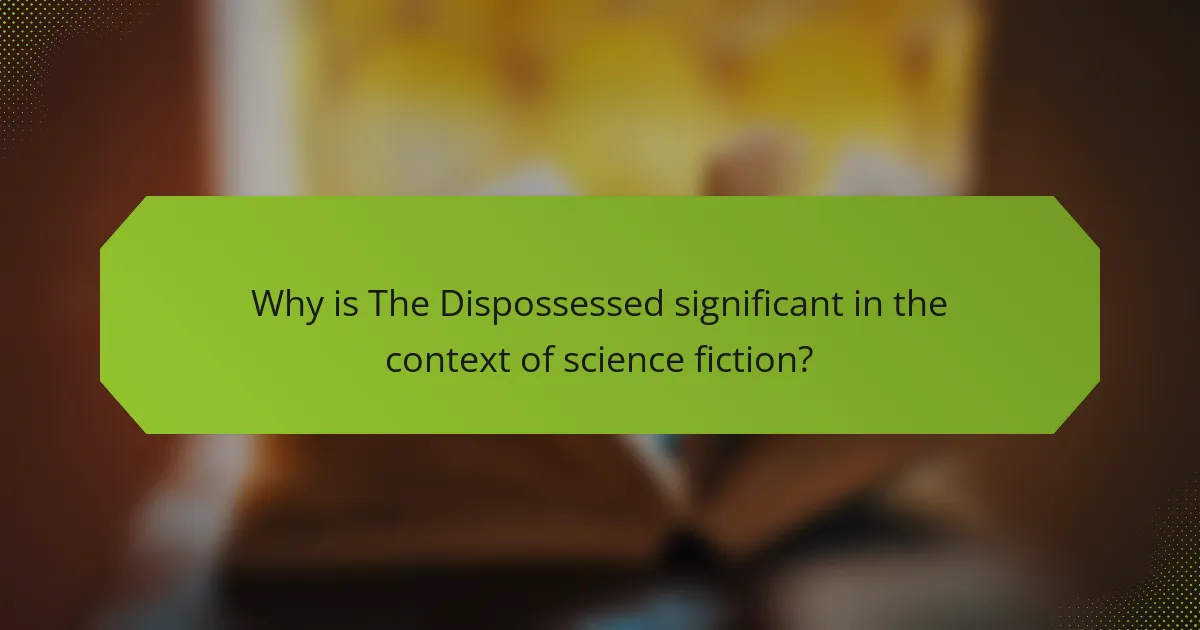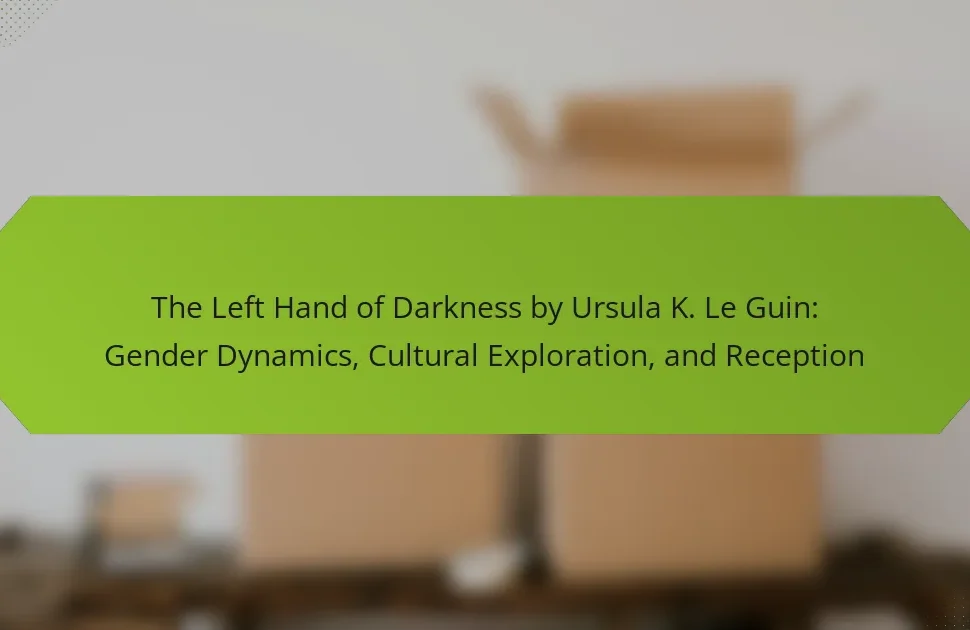Ursula K. Le Guin’s “The Dispossessed” explores the complexities of anarchism and societal structures. It contrasts the anarchist world of Anarres with the capitalist society of Urras. The narrative critiques both systems while highlighting themes of freedom and oppression. Its critical reception underscores its significance in feminist and political discourse within science fiction.

How does anarchism manifest in The Dispossessed?
Anarchism in The Dispossessed manifests through the exploration of a society without centralized authority, emphasizing individual freedom and communal living. The contrasting worlds of Anarres and Urras highlight the challenges of implementing anarchist principles. Anarres embodies a form of anarchism that rejects capitalism and hierarchies, promoting mutual aid and cooperation. The novel critiques the idealism of anarchism by illustrating its complexities and the human tendencies that challenge its implementation. Le Guin’s portrayal of Shevek’s journey reflects the struggle for personal and societal liberation, making a poignant statement on the nature of freedom.
What philosophical principles underpin the anarchist society depicted?
The anarchist society in “The Dispossessed” is underpinned by principles of mutual aid, freedom, and non-hierarchy. These ideals promote a cooperative community that prioritizes individual autonomy while fostering collective responsibility. Anarchism in this context emphasizes the rejection of oppressive structures, advocating for a society built on voluntary association and egalitarian relationships. The dual worlds portrayed reflect contrasting societal values, highlighting the philosophical tension between individualism and collectivism.
Which characters embody anarchist ideals?
Shevek and his fellow anarchists in “The Dispossessed” embody anarchist ideals through their commitment to non-hierarchical structures and mutual aid. Shevek seeks to bridge the divide between the capitalist world of Urras and the anarchist society of Anarres. His journey reflects the struggle for freedom and the importance of individual autonomy. The characters’ interactions emphasize the value of cooperation and the rejection of oppressive systems.
How does the portrayal of government contrast with anarchist values?
The portrayal of government in “The Dispossessed” contrasts sharply with anarchist values by depicting state control as oppressive. Anarchism advocates for a stateless society where individuals freely cooperate. In the novel, the authoritarian structure of Urras symbolizes the constraints of government, while Anarres represents the potential for egalitarianism. This duality highlights the tension between hierarchical control and the anarchist ideal of autonomy. Le Guin critiques the failures of both systems, emphasizing the complexities of human nature and societal organization.

What are the dual worlds presented in The Dispossessed?
The dual worlds in “The Dispossessed” are Anarres and Urras, representing contrasting societal structures. Anarres embodies anarchist principles, promoting communal living and shared resources. Urras, in contrast, reflects capitalist values, emphasizing wealth and individualism. This dichotomy explores themes of freedom, oppression, and the complexities of human nature. The narrative critiques both systems, revealing their strengths and weaknesses. Le Guin’s portrayal invites readers to reflect on the nature of society and the possibilities of alternative futures.
How do Anarres and Urras differ in societal structure?
Anarres and Urras differ significantly in societal structure. Anarres embodies anarchism with communal ownership and egalitarian principles. In contrast, Urras features capitalism, marked by class divisions and private property. Anarres prioritizes collective decision-making, while Urras emphasizes individual wealth accumulation. The contrasting structures highlight the themes of freedom and oppression in “The Dispossessed.”
What role does geography play in shaping the characters’ experiences?
Geography significantly influences characters’ experiences in “The Dispossessed.” The contrasting worlds of Urras and Anarres shape their social structures and personal identities. Urras, with its wealth and capitalism, offers opportunities but also fosters inequality. Anarres, in its anarchist framework, promotes communal living but restricts individual freedom. These geographical settings create distinct challenges and perspectives for the characters, highlighting the impact of environment on ideology and personal choices.
How do the worlds reflect the themes of freedom and oppression?
The worlds in “The Dispossessed” illustrate themes of freedom and oppression through contrasting societies. Anarres represents anarchism and communal living, emphasizing individual freedom and collective responsibility. Urras embodies capitalism and hierarchy, showcasing oppression through social inequality and exploitation. These dual worlds highlight the complexities of freedom and the consequences of different political systems. Le Guin’s narrative critiques both extremes, revealing the challenges of achieving true liberation.

Why is The Dispossessed significant in the context of science fiction?
The Dispossessed is significant in science fiction for its exploration of anarchism and contrasting societies. Ursula K. Le Guin presents two distinct worlds: Urras, a capitalist society, and Anarres, an anarchist utopia. This duality allows for critical examination of political ideologies and human nature. The novel challenges conventional narratives by emphasizing the complexities of freedom and societal structure. Its critical reception highlights its influence on feminist and political discourse within the genre, establishing it as a pivotal work in speculative fiction.
How does the novel challenge traditional genre conventions?
The novel challenges traditional genre conventions by blending science fiction with social philosophy. It presents dual worlds that explore anarchism and capitalism, diverging from typical genre tropes. The narrative structure emphasizes character development over plot, allowing for deeper thematic exploration. This approach invites critical reception that often highlights its innovative perspective on societal constructs.
What impact has it had on subsequent works of speculative fiction?
The Dispossessed has significantly influenced subsequent works of speculative fiction by exploring themes of anarchism and dual worlds. Its portrayal of contrasting societies has inspired authors to examine political structures and social dynamics. For example, writers like Kim Stanley Robinson and N.K. Jemisin have drawn on Le Guin’s exploration of utopia and dystopia. Additionally, the novel’s critical reception has encouraged deeper discussions about the role of speculative fiction in addressing real-world issues. Its legacy continues to shape narratives that challenge conventional ideologies and promote alternative visions of society.

Which themes resonate with contemporary social movements?
Themes resonating with contemporary social movements include anarchism and duality, as explored in Ursula K. Le Guin’s “The Dispossessed.” The novel critiques authority and promotes alternative societal structures. Its portrayal of contrasting worlds reflects ongoing discussions about freedom and oppression. Additionally, critical reception highlights its relevance in modern activism, emphasizing the need for equitable systems.
How do readers interpret the themes of capitalism and socialism?
Readers interpret the themes of capitalism and socialism in “The Dispossessed” through contrasting societal structures. Le Guin presents capitalism as an oppressive force, highlighting individualism and competition. In contrast, socialism is depicted as a communal ideal, emphasizing cooperation and collective well-being. The dual worlds of Anarres and Urras illustrate these themes, with Anarres representing anarchism and Urras embodying capitalist values. This duality invites critical reflection on the merits and flaws of each system, prompting readers to question the viability of both. The reception of the novel further underscores its relevance, as discussions around capitalism and socialism continue to resonate in contemporary society.
What parallels can be drawn to modern anarchist movements?
Modern anarchist movements share themes of decentralization and anti-authoritarianism with “The Dispossessed.” Both advocate for social equality and challenge oppressive structures. Anarchism in contemporary contexts emphasizes community autonomy, paralleling the novel’s dual worlds where freedom and oppression coexist. Additionally, the critique of capitalism in both spheres highlights the pursuit of alternative societal models. These connections illustrate how Le Guin’s work resonates with ongoing struggles for justice and liberation today.

What is the critical reception of The Dispossessed over time?
The critical reception of The Dispossessed has evolved significantly since its publication in 1974. Initially, it received mixed reviews, with some praising its exploration of anarchism and dual worlds while others criticized its pacing and complexity. Over time, it gained recognition as a seminal work in science fiction, celebrated for its philosophical depth and social commentary. Critics now often highlight its unique portrayal of utopian and dystopian societies, reflecting ongoing discussions about political ideologies. The novel’s impact on feminist and anarchist literature has solidified its status, making it a staple in academic discussions.
How have literary critics viewed its contributions to feminist literature?
Literary critics have recognized “The Dispossessed” as a significant contribution to feminist literature due to its exploration of gender roles and societal structures. The novel presents a dual-world setting, contrasting a capitalist society with an anarchist utopia. Critics highlight how Le Guin challenges traditional gender norms, portraying female characters with depth and agency. This nuanced representation has led to discussions about the intersection of feminism and anarchism in literature. The work’s impact is evident in its continued relevance within feminist discourse, influencing subsequent feminist writers and theorists.
Which awards and recognitions has the novel received?
The Dispossessed by Ursula K. Le Guin has received multiple prestigious awards. It won the Hugo Award for Best Novel in 1975 and the Nebula Award for Best Novel in 1974. Additionally, it has been recognized as one of the greatest science fiction novels, receiving accolades from various literary critics and organizations. The novel’s exploration of anarchism and dual worlds has contributed to its critical acclaim and enduring relevance in the genre.

What unique narrative techniques does Ursula K. Le Guin employ?
Ursula K. Le Guin employs unique narrative techniques such as dual perspective storytelling, non-linear timelines, and rich world-building. These methods deepen the exploration of anarchism and societal structures in “The Dispossessed.” Le Guin’s use of unreliable narrators adds complexity, inviting readers to question reality. Additionally, she blends philosophical discourse with character-driven plots, enhancing thematic depth and engagement.
How does the use of unreliable narration affect reader perception?
Unreliable narration in “The Dispossessed” challenges reader perception by creating ambiguity and prompting critical engagement. This narrative technique reflects the dual worlds of Anarres and Urras, making readers question the truth of events and characters. The distinct perspectives push readers to analyze underlying themes of anarchism and societal structures. As a result, the reader’s interpretation becomes an active part of the narrative experience, enhancing critical reception and discussion.
In what ways does Le Guin’s writing style enhance thematic depth?
Le Guin’s writing style deepens thematic exploration through rich imagery, nuanced character development, and philosophical dialogue. Her use of dual worlds in “The Dispossessed” illustrates contrasting ideologies, enhancing the reader’s understanding of anarchism. The intricate language invites reflection on societal constructs, fostering critical engagement with the text. Additionally, her unique narrative structure, including non-linear timelines, challenges conventional storytelling, allowing for a more profound thematic resonance.

What lessons can be drawn from The Dispossessed for modern readers?
The Dispossessed offers valuable insights for modern readers about the complexities of societal structures and individual freedom. The novel presents contrasting worlds that challenge conventional ideas of capitalism and anarchism. Readers can reflect on the impact of political ideologies on personal identity and community dynamics.
Additionally, the exploration of duality in the narrative encourages critical thinking about the balance between personal ambition and collective responsibility. The book’s critical reception highlights its relevance in discussions about utopian ideals and their practical implications today.
These lessons prompt readers to question their own societal roles and the structures they inhabit, fostering a deeper understanding of freedom and cooperation in contemporary life.
How can the themes of the novel inform discussions on societal structure?
The themes of “The Dispossessed” highlight the complexities of societal structures through contrasting anarchism and capitalism. This duality encourages discussions on freedom, oppression, and the potential for alternative social systems. Le Guin’s portrayal of Utopia and its flaws serves as a critical lens for examining real-world societal dynamics. The novel challenges readers to reflect on the values that underpin their own societies and consider the implications of different governance models.
What practical insights can readers apply to their own lives?
Readers can apply insights from “The Dispossessed” by reflecting on the contrast between individualism and collectivism. This novel illustrates the complexities of societal structures and encourages critical thinking about governance. By examining the dual worlds of Anarres and Urras, readers can question their own societal norms and values. Engaging with these themes fosters a deeper understanding of personal and communal responsibilities.




